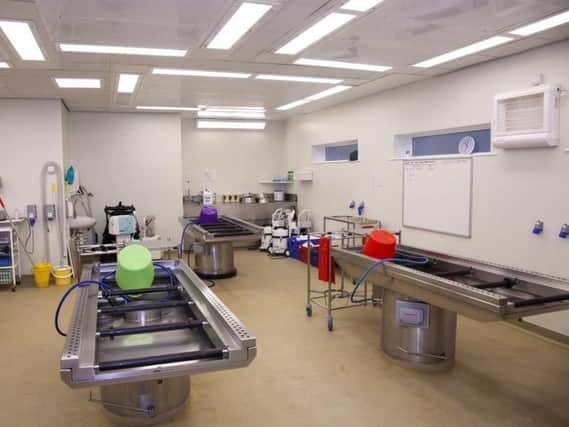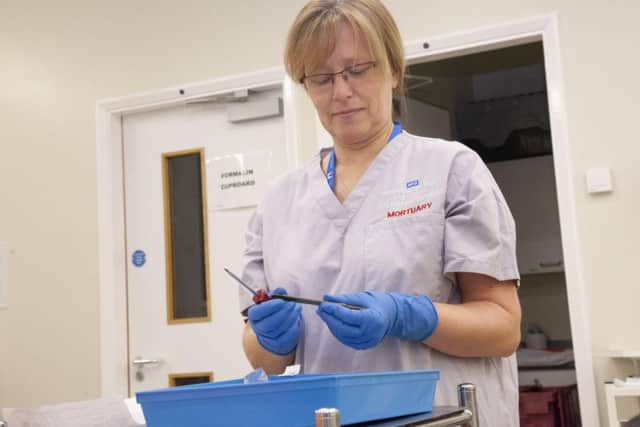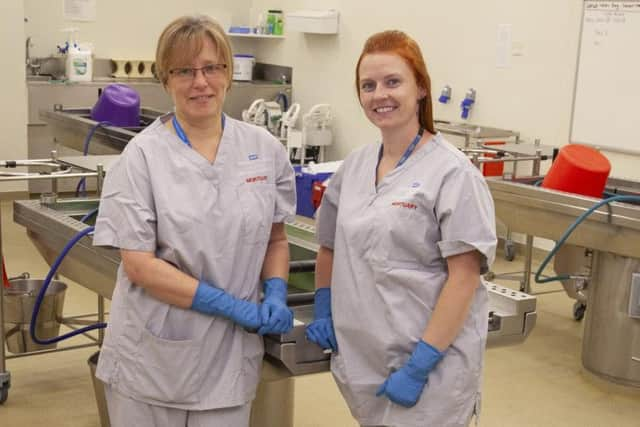Take a look inside Wigan Infirmary's mortuary


At Wigan Infirmary’s mortuary, though, the final chapter of our existence on the planet and what happens when we shuffle off this mortal coil is a day-to-day business.
Other news: Dreaded norovirus shuts ward at Wigan InfirmaryAnd the team labouring away in the secluded location of Rose Cottage could not be prouder that they are the ones serving Wiganers experiencing the ordeal of grief at losing someone close to them.
Advertisement
Hide AdAdvertisement
Hide AdA four-strong group takes on the often incredibly heavy workload which sees them deal with around 2,500 deaths each year (intriguingly, a similar figure to the number of annual births in Wigan).


It’s certainly an unusual line of work, and one which is quite widely misunderstood, but it’s one which anatomical pathology technologist (APT) Natalie Smith and senior APT Emma Romeling are extremely passionate about.
Natalie, who only joined the mortuary in Wigan around two months ago, said: “It used to be called a morgue which sounds very dark and gloomy and people think the job must be like that.
“It’s a very sad situation to be working in with people passing away but you have got to give people dignity in death. They cannot just be forgotten about, because their families aren’t going to forget them.
Advertisement
Hide AdAdvertisement
Hide Ad“People think that when someone passes away it ends there and it doesn’t. For me there’s more to do and to be able to give something to the families when they are distressed and grieving gives a sense of pride.


“Families when they come to us might want to cry or shout and scream and they might not want to put that on their family and friends.
“They might want to speak to someone impartial and we can provide that as well as looking after the person who has passed away.”
Emma added: “It’s the final thing you can do for somebody. Families often say they don’t know how we can do this job but I say it’s because of you and your loved ones.
Advertisement
Hide AdAdvertisement
Hide Ad“People sometimes say to us not to leave them on their own and we assure them they are not.
“It’s not just post-mortems. We are looking after families, liaising with coroners, funeral directors and GPs, working with doctors and nurses from the wards. We also sort out blood tissue donations. It’s inexhaustible.
“We look after stillbirths which is an absolute honour. We meet the families, they come down and bring their babies here and it gives them comfort.
“We pull out all the stops for everybody we can. If families want to come and say good night to their children at bed time we will be here so they can do that.”
Advertisement
Hide AdAdvertisement
Hide AdThe Wigan mortuary is fairly small but has a great deal to do, with both hospital and community deaths being referred to the team led by mortuary and bereavement services manager Kathleen Robinson.
So far in 2018 an incredible 605 post-mortems have been carried out by pathologists and mortuary staff, an increase on the same time last year.
Together with an on-call system ensuring grieving families are always able to speak to someone when they need it most, that means long hours and an extraordinary degree of commitment.
Emma said: “It can be crazy. One day recently I came into work at 7.30am and got a call about 3.30pm to say the tissue service was here so I didn’t get home until 6.30pm.
Advertisement
Hide AdAdvertisement
Hide Ad“We can be out several times during the night and still be back in at 7.30 in the morning to carry on with our duties.
“Last year there was an increase in deaths around Christmas, Kath and I came into work at 2.30am and left at 6pm just to make sure everything ran smoothly.
“Anyone of us who is on call and has an issue can ring any other member of the team and say they need help and they would come and help out.”
The area the public visit is extremely sensitively laid out, with two viewing rooms screened by curtains and the one where the bodies are placed for relatives to see having the cosy and peaceful air of a bedroom.
Advertisement
Hide AdAdvertisement
Hide AdBoth Emma and Natalie ended up working in the mortuary following very different careers elsewhere.
Natalie was previously a team leader in pubs before deciding she wanted to work in a mortuary and put a message on an answering machine at the Royal Liverpool Hospital asking for voluntary or trainee posts.
The employee who called back told her she would have to have an informal interview and also watch a post-mortem to ensure she could handle the job requirements, and got a place in the department after passing that unfazed.
She had to self-fund her training and it was while qualifying that she met Emma, who was her assessor. After qualifying in July 2017 she found herself having to search for full-time posts and was delighted to have her application for Wrightington, Wigan and Leigh (WWL) NHS Foundation Trust accepted.
Advertisement
Hide AdAdvertisement
Hide AdEmma also found herself having a baptism of fire when she arrived to work in health.
She said: “I was going back to work when my son was 10 and I applied for clerical officer posts as that was what I had done before.
“I was told there were jobs on a ward and in the mortuary and I started here when the new building opened in 2001.
“On my first day I was told part of my job would be sitting behind the windows of the post-mortem room recording all the information from the post-mortems.
Advertisement
Hide AdAdvertisement
Hide Ad“Someone else in the department was trying to qualify but when they didn’t manage it and decided not to try again I said I would have a crack at the course. I did a certificate and a diploma and moved up to senior tech as soon as I qualified.”
Both Emma and Natalie say there are fewer misconceptions about mortuaries and the work than there used to be but recognise they have a very different view of death to much of the population.
Emma said: “When I started in 2001 it was very much a taboo subject. Death just wasn’t spoken about at all. I didn’t really know mortuaries existed at hospitals.”
Natalie added: “There just doesn’t need to be that taboo. Everybody will come across death at some point in their lives so it needs to be spoken about more.”